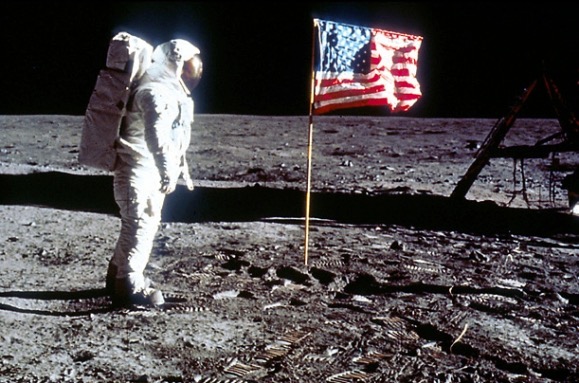

- © 2003 - 2025 Dynamix Productions, Inc. Contact Us 0



Buzz Aldrin subliminally making the flag fly straight.
"Fly straight, you beep flag."
When astronauts first walked on the moon, everyone was glued to the television. I was eight-years-old and can remember it like yesterday.
Beep. Beep.
We copy you down, Eagle.
Beep. Beep.
Engine arm is off. (Pause) Houston, Tranquility Base here. The Eagle has landed.
Beep. Beep.
What the beep? All those old NASA transmissions seem to have that beeping in the recording. What the beep is it? It's actually two, and they're called Quindar tones.
They were named after the manufacturer, but I think it sounds very '60's Sci-Fi:
"I am from the planet Quindar in the Crouton system. We think your planet is just groovy, baby!"
In a nutshell, the tones signaled remote transmitters to turn on or off. Installing two separate lines of communications, one voice and one data, between Cap Com (Capsule Communications on earth) and the transmitters around the globe would have been extremely costly. So they went with a single channel, and that's why we hear them in the recordings.
This wasn't a new idea. All of us who had to endure a film strip in school remember the tones that told the teacher to advance the film strip. Radio networks used it to signal its affiliates, like the "N - B - C" chimes.
Later, radio networks adopted a different method to cue automatic playback systems at their affiliates with "sub-audible" tones. In reality, they were just low tones like 25. 35, 50 or 75 Hz that were filtered out of the on-air stream and redirected to playback equipment.
An announcer's voice can also be a cue for radio stations. In sports broadcasting for instance, how an announcer goes to a commercial break can cue the broadcast engineer at the local radio station whether or not to play local commercials. If a block of commercials will be all network spots, the announcer might say:
"We'll be back after this on SRN."
If the upcoming break should include local commercials, the announcer might say:
"We'll be back after this. You're listening to the Sports Radio Network."
But the ultimate in hidden sounds has to be subliminal messages in advertising, public address systems, and music. Remember "Paul is dead" from The White Album? How about rumors of hidden messages in department store music, factory brown noise, or even advertising? It's easy enough to do, but is it effective? Studies have found that visual stimuli are more effective than audible stimuli. But it doesn't stop people from trying. I think I'll try. Say the following aloud:
Isn't it a nice day. use You should really go to the country. dynamix Take a picnic basket along. for Enjoy the breeze. all Marvel at all the green. your Smell the blooming flowers. audio Enjoy yourself!